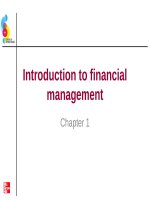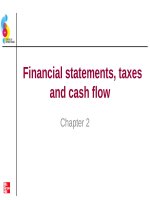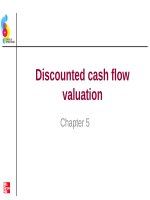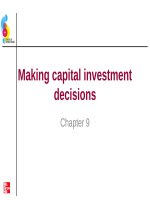Lecture Essentials of corporate finance (2/e) – Chap 9: Making capital investment decisions
Bạn đang xem bản rút gọn của tài liệu. Xem và tải ngay bản đầy đủ của tài liệu tại đây (170.94 KB, 39 trang )
Making capital investment
decisions
Chapter 9
Key concepts and skills
• Understand how to determine the
relevant cash flows for a proposed
investment
• Understand how to analyse a project’s
projected cash flows
• Understand how to evaluate an
estimated NPV
Copyright ©2011 McGraw-Hill Australia Pty Ltd
PPTs t/a Essentials of Corporate Finance 2e by Ross et al.
Slides prepared by David E. Allen and Abhay K. Singh
9-2
Chapter outline
• Project cash flows: A first look
• Incremental cash flows
• Pro forma financial statements and project
cash flows
• More on project cash flow
• Evaluating NPV estimates
• Scenario and other what-if analyses
• Additional considerations in capital
budgeting
Copyright ©2011 McGraw-Hill Australia Pty Ltd
PPTs t/a Essentials of Corporate Finance 2e by Ross et al.
Slides prepared by David E. Allen and Abhay K. Singh
9-3
Relevant cash flows
• The cash flows that should be included
in a capital budgeting analysis are
those that will occur only if the project
is accepted.
• These cash flows are called
incremental cash flows.
• The stand-alone principle allows us to
analyse each project in isolation from
the firm, simply by focusing on
incremental cash flows.
Copyright ©2011 McGraw-Hill Australia Pty Ltd
PPTs t/a Essentials of Corporate Finance 2e by Ross et al.
Slides prepared by David E. Allen and Abhay K. Singh
9-4
Asking the right question
• You should always ask yourself ‘Will
this cash flow occur ONLY if we accept
the project?’
– If the answer is ‘yes’, it should be included
in the analysis because it is incremental.
– If the answer is ‘no’, it should not be
included in the analysis because it will
occur anyway.
– If the answer is ‘in part’, then we should
include the part that occurs because of the
project.
Copyright
©2011 McGraw-Hill Australia Pty Ltd
PPTs t/a Essentials of Corporate Finance 2e by Ross et al.
Slides prepared by David E. Allen and Abhay K. Singh
9-5
Common types of cash
flows
• Sunk costs—costs that have accrued in the
past
– Should not be considered in investment decision
• Opportunity costs—costs of lost options
• Side effects
– Positive side effects—benefits to other projects
– Negative side effects—costs to other projects
• Changes in net working capital
• Financing costs
– Not a part of investment decision
• Tax
effects
Copyright ©2011 McGraw-Hill Australia Pty Ltd
PPTs t/a Essentials of Corporate Finance 2e by Ross et al.
Slides prepared by David E. Allen and Abhay K. Singh
9-6
Pro forma statements
and cash flow
• Pro forma financial statements
– Project future operations
• Capital budgeting relies heavily on pro
forma accounting statements, particularly
income statements.
• Computing cash flows—refresher
– Operating cash flow (OCF) = EBIT +
Depreciation – Taxes
– OCF = Net income + Depreciation when there
is no interest expense
– Cash flow from assets (CFFA) = OCF – Net
capital spending (NCS) – Changes in NWC
Copyright ©2011 McGraw-Hill Australia Pty Ltd
PPTs t/a Essentials of Corporate Finance 2e by Ross et al.
Slides prepared by David E. Allen and Abhay K. Singh
9-7
Shark attractant project
•
•
•
•
•
Estimated sales
Sales price per can
Cost per can
Estimated life
Fixed costs
000/year
• Initial equipment cost
$90,000
50 000 cans
$4.00
$2.50
3 years
$12
– 100% depreciated over 3-year life
• Investment in NWC
• Tax rate
Copyright ©2011 McGraw-Hill Australia Pty Ltd
• Cost
of capital
PPTs t/a Essentials
of Corporate Finance 2e by Ross et al.
Slides prepared by David E. Allen and Abhay K. Singh
$20 000
30%
20%
9-8
Pro forma income statement
Shark attractant project—Table 9.1
Sales (50 000 units at
$4.00/unit)
$200 000
Variable Costs ($2.50/unit)
125 000
Gross profit
$ 75 000
Fixed costs
12 000
Depreciation ($90 000 / 3)
30 000
EBIT
Taxes (30%)
Net Income
Copyright ©2011 McGraw-Hill Australia Pty Ltd
PPTs t/a Essentials of Corporate Finance 2e by Ross et al.
Slides prepared by David E. Allen and Abhay K. Singh
$ 33 000
9 900
$ 23 100
9-9
Projected capital requirements
—Table 9.2
Year
0
NWC
Net fixed
assets
Total
investment
1
2
3
$20 000
$20 000
$20 000
$20 000
90 000
60 000
30 000
0
$110 000
$80 000
$50 000
$20 000
NFA declines by the amount of depreciation each year.
Investment = book or accounting value, not market value.
Copyright ©2011 McGraw-Hill Australia Pty Ltd
PPTs t/a Essentials of Corporate Finance 2e by Ross et al.
Slides prepared by David E. Allen and Abhay K. Singh
9-10
Projected total cash flows—
Table 9.5
Year
0
OCF
1
$53 100
Change in
NWC
-$20 000
Capital
spending
-$90 000
Total project
cash flow
-$110 00
2
$53 100
3
$53 100
20 000
$53 100
Copyright ©2011 McGraw-Hill Australia Pty Ltd
PPTs t/a Essentials of Corporate Finance 2e by Ross et al.
Slides prepared by David E. Allen and Abhay K. Singh
$53 100
$73 100
9-11
Shark attractant project
Year
Sales
Variable Costs
Gross Profit
Fixed Costs
Depreciation
EBIT
Taxes
Net Income
Pro Forma Income Statement
0
1
200,000
125,000
75,000
12,000
30,000
33,000
9,900
23,100
Operating Cash Flow
Changes in NWC
Net Capital Spending
Cash Flow From Assets
Net Present Value
IRR
Cash Flows
53,100
-20,000
-90,000
-110,000
53,100
2
200,000
125,000
75,000
12,000
30,000
33,000
9,900
23,100
3
200,000
125,000
75,000
12,000
30,000
33,000
9,900
23,100
53,100
53,100
20,000
53,100
73,100
$13,428.24
27.25%
OCF = EBIT + Depreciation – Taxes
OCF = Net Income + Depreciation (if no interest)
Copyright ©2011 McGraw-Hill Australia Pty Ltd
PPTs t/a Essentials of Corporate Finance 2e by Ross et al.
Slides prepared by David E. Allen and Abhay K. Singh
9-12
Making the decision
• Now that we have the cash flows, we can
apply the techniques that we learned in
Chapter 8.
• Enter the cash flows into the calculator and
compute NPV and IRR.
– CF0 = -110 000; C01 = 53 100; F01 = 2; C02 = 73
100
– [NPV]; I = 20; [CPT] [NPV] = 13 428
– [CPT] [IRR] = 27.3%
• Do we accept or reject the project?
Copyright ©2011 McGraw-Hill Australia Pty Ltd
PPTs t/a Essentials of Corporate Finance 2e by Ross et al.
Slides prepared by David E. Allen and Abhay K. Singh
9-13
The tax shield approach
• You can also find operating cash flow using
the tax shield approach.
• OCF = (Sales – Costs)(1 – T)
+Depreciation*T
• This form may be particularly useful when the
major incremental cash flows are the
purchase of equipment and the associated
depreciation tax shield, such as when you
are choosing between two different
machines.
Copyright ©2011 McGraw-Hill Australia Pty Ltd
PPTs t/a Essentials of Corporate Finance 2e by Ross et al.
Slides prepared by David E. Allen and Abhay K. Singh
9-14
More on NWC
• Why do we have to consider changes in
NWC separately?
– AAS require that sales be recorded on the
income statement when made, not when cash
is received.
– AAS also require that we record cost of goods
sold when the corresponding sales are made,
regardless of whether we have actually paid
our suppliers yet.
– Finally, we have to buy inventory to support
Copyright
©2011although
McGraw-Hill Australia
Ltd
sales
wePtyhaven’t
collected cash.
PPTs t/a Essentials of Corporate Finance 2e by Ross et al.
Slides prepared by David E. Allen and Abhay K. Singh
9-15
Depreciation and capital
budgeting
• The depreciation expense used for
capital budgeting should be the
depreciation schedule required by the
ATO for tax purposes.
• Depreciation itself is a non-cash
expense. Consequently, it is only
relevant because it affects taxes.
• Depreciation tax shield = DT
– D = depreciation expense
– T = marginal tax rate
Copyright ©2011 McGraw-Hill Australia Pty Ltd
PPTs t/a Essentials of Corporate Finance 2e by Ross et al.
Slides prepared by David E. Allen and Abhay K. Singh
9-16
Computing depreciation
• Prime cost (straight-line) depreciation
– D = (Initial cost –Salvage)/Number of
years
– Most assets are depreciated straight-line
to zero for tax purposes.
• Diminishing value depreciation
– Need to know which depreciation rate is
appropriate for tax purposes.
– Multiply percentage by the written-down
value at the beginning of the year.
– Depreciate to zero.
Copyright ©2011 McGraw-Hill Australia Pty Ltd
PPTs t/a Essentials of Corporate Finance 2e by Ross et al.
Slides prepared by David E. Allen and Abhay K. Singh
9-17
After-tax salvage
• If the salvage value is different from the
book value of an asset, there is a tax
effect.
• Book value = Initial cost – Accumulated
depreciation.
• After-tax salvage = Salvage –
T(salvage – book value).
Copyright ©2011 McGraw-Hill Australia Pty Ltd
PPTs t/a Essentials of Corporate Finance 2e by Ross et al.
Slides prepared by David E. Allen and Abhay K. Singh
9-18
Tax effect on salvage
• Net salvage cash flow
= SP - (SP-BV)(T)
•
Where:
– SP = selling price
– BV = book value
– T = corporate tax rate
Copyright ©2011 McGraw-Hill Australia Pty Ltd
PPTs t/a Essentials of Corporate Finance 2e by Ross et al.
Slides prepared by David E. Allen and Abhay K. Singh
9-19
Example:
Depreciation and after-tax salvage
• Car purchased for $12 000
• 8-year property
• Marginal tax rate = 30%
Prime Cost @12.5%
Year
0
1
2
3
4
5
6
7
8
Depreciation
1500
1500
1500
1500
1500
1500
1500
1500
End BV
12000
10500
9000
7500
6000
4500
3000
1500
0
Diminishing Value @18.75%
Beg BV
$ 12,000.00 $
$ 9,750.00 $
$ 7,921.88 $
$ 6,436.52 $
$ 5,229.68 $
$ 4,249.11 $
$ 3,452.40 $
$ 2,805.08 $
Copyright ©2011 McGraw-Hill Australia Pty Ltd
PPTs t/a Essentials of Corporate Finance 2e by Ross et al.
Slides prepared by David E. Allen and Abhay K. Singh
Deprec
2,250.00
1,828.13
1,485.35
1,206.85
980.56
796.71
647.33
525.95
$
$
$
$
$
$
$
$
End BV
$12,000
9,750.00
7,921.88
6,436.52
5,229.68
4,249.11
3,452.40
2,805.08
2,279.13
9-20
Salvage value and tax
effects
Prime Cost @12.5%
Year
0
1
2
3
4
5
6
7
8
Depreciation
1500
1500
1500
1500
1500
1500
1500
1500
End BV
12000
10500
9000
7500
6000
4500
3000
1500
0
Diminishing Value @18.75%
Beg BV
$ 12,000.00
$ 9,750.00
$ 7,921.88
$ 6,436.52
$ 5,229.68
$ 4,249.11
$ 3,452.40
$ 2,805.08
$
$
$
$
$
$
$
$
Deprec
2,250.00
1,828.13
1,485.35
1,206.85
980.56
796.71
647.33
525.95
$
$
$
$
$
$
$
$
End BV
$12,000
9,750.00
7,921.88
6,436.52
5,229.68
4,249.11
3,452.40
2,805.08
2,279.13
Net salvage cash flow = SP - (SP-BV)(T)
If sold at EOY 5 for $5100:
NSCF = 5100 - (5100 – 4249.11)(.3) = $4844.733
= $5100 – 255.267= $ 4844.733
If sold at EOY 2 for $4600:
NSCF = 4600 - (4600 – 7921.88)(.3) = $ 5596.564
= $4600 – ( -996.564) = $ 5596.564
Copyright ©2011 McGraw-Hill Australia Pty Ltd
PPTs t/a Essentials of Corporate Finance 2e by Ross et al.
Slides prepared by David E. Allen and Abhay K. Singh
9-21
Majestic Mulch and Compost Co.
(MMCC)
Majestic Mulch and Compost Company (MMCC)
YEAR
0
1
Background Data:
Unit Sales Estimates
3,000
Variable Cost /unit $
60.00
Fixed Costs per year$
25,000.00
Sale Price per unit $
120.00
$ 120.00
Tax Rate
30.0%
Required Return on Project 15.0%
Yr 0 NWC
$
20,000.00
NWC % of sales
15%
Equipment cost - installed
$
800,000
Salvage Value in year 8
20% of equipment cost
Depreciation Calculations:
Equipment Depreciable Base
800,000
Prime Cost % (Eqpt-7 yr)
Recovery Allowance
Book Value
After-Tax Salvage Value
Salvage Value
Book Value (Year 8)
Capital Gain/Loss
Taxes
Net SV (SV-Taxes)
20%
2
3
4
5
6
5,000
6,000
6,500
6,000
5,000
$ 120.00
$ 120.00
$ 110.00
$ 110.00
$ 110.00
7
$
8
4,000
3,000
110.00
$ 110.00
15.00%
120,000
680,000
15.00%
120,000
560,000
15.00%
120,000
440,000
15.00%
120,000
320,000
15.00%
120,000
200,000
15.00%
120,000
80,000
15.00%
80,000
0
0
0
54,000
90,000
108,000
107,250
99,000
82,500
66,000
49,500
160,000
0
160,000
48,000
112,000
Required Net Working Capital Investment
20,000
Copyright ©2011 McGraw-Hill Australia Pty Ltd
PPTs t/a Essentials of Corporate Finance 2e by Ross et al.
Slides prepared by David E. Allen and Abhay K. Singh
9-22
MMCC—Depreciation and after-tax
salvage
Table 9.9
Majestic Mulch and Compost Company (MMCC)
YEAR
0
1
Background Data:
Unit Sales Estimates
3,000
Variable Cost /unit $
60.00
Fixed Costs per year$
25,000.00
Sale Price per unit $
120.00
$ 120.00
Tax Rate
30.0%
Required Return on Project 15.0%
Yr 0 NWC
$
20,000.00
NWC % of sales
15%
Equipment cost - installed
$
800,000
Salvage Value in year 8
20% of equipment cost
Depreciation Calculations:
Equipment Depreciable Base
800,000
Prime Cost % (Eqpt-7 yr)
Recovery Allowance
Book Value
After-Tax Salvage Value
Salvage Value
Book Value (Year 8)
Capital Gain/Loss
Taxes
Net SV (SV-Taxes)
20%
2
3
4
5
6
5,000
6,000
6,500
6,000
5,000
$ 120.00
$ 120.00
$ 110.00
$ 110.00
$ 110.00
$
7
8
4,000
3,000
110.00
$ 110.00
15.00%
120,000
680,000
15.00%
120,000
560,000
15.00%
120,000
440,000
15.00%
120,000
320,000
15.00%
120,000
200,000
15.00%
120,000
80,000
15.00%
80,000
0
0
0
54,000
90,000
108,000
107,250
99,000
82,500
66,000
49,500
160,000
0
160,000
48,000
112,000
Required Net Working Capital Investment
20,000
Copyright ©2011 McGraw-Hill Australia Pty Ltd
PPTs t/a Essentials of Corporate Finance 2e by Ross et al.
Slides prepared by David E. Allen and Abhay K. Singh
9-23
MMCC—Net working capital
Table 9.11
Majestic Mulch and Compost Company (MMCC)
YEAR
0
1
Background Data:
Unit Sales Estimates
3,000
Variable Cost /unit $
60.00
Fixed Costs per year$
25,000.00
Sale Price per unit $
120.00
$ 120.00
Tax Rate
30.0%
Required Return on Project 15.0%
Yr 0 NWC
$
20,000.00
NWC % of sales
15%
Equipment cost - installed
$
800,000
Salvage Value in year 8
20% of equipment cost
Depreciation Calculations:
Equipment Depreciable Base
800,000
Prime Cost % (Eqpt-7 yr)
Recovery Allowance
Book Value
After-Tax Salvage Value
Salvage Value
Book Value (Year 8)
Capital Gain/Loss
Taxes
Net SV (SV-Taxes)
20%
2
3
4
5
6
5,000
6,000
6,500
6,000
5,000
$ 120.00
$ 120.00
$ 110.00
$ 110.00
$ 110.00
7
$
8
4,000
3,000
110.00
$ 110.00
15.00%
120,000
680,000
15.00%
120,000
560,000
15.00%
120,000
440,000
15.00%
120,000
320,000
15.00%
120,000
200,000
15.00%
120,000
80,000
15.00%
80,000
0
0
0
54,000
90,000
108,000
107,250
99,000
82,500
66,000
49,500
160,000
0
160,000
48,000
112,000
Required Net Working Capital Investment
20,000
Copyright ©2011 McGraw-Hill Australia Pty Ltd
PPTs t/a Essentials of Corporate Finance 2e by Ross et al.
Slides prepared by David E. Allen and Abhay K. Singh
9-24
MMCC—Pro forma income statements
YEAR
Initial Investment
Equipment Cost
Sales
Variable Costs
Fixed Costs
Depreciation (Eqpt))
EBIT
Taxes
Net Operating Income
Add back Depreciation
CASH FLOW from Operations
NWC investment & Recovery
Salvage Value
TOTAL PROJECTED CF
1
2
3
4
5
6
7
8
-20,000
360,000
180,000
25,000
120,000
35,000
10,500
24,500
120,000
144,500
-34,000
600,000
300,000
25,000
120,000
155,000
46,500
108,500
120,000
228,500
-36,000
720,000
360,000
25,000
120,000
215,000
64,500
150,500
120,000
270,500
-18,000
715,000
390,000
25,000
120,000
180,000
54,000
126,000
120,000
246,000
750
660,000
360,000
25,000
120,000
155,000
46,500
108,500
120,000
228,500
8,250
550,000
300,000
25,000
120,000
105,000
31,500
73,500
120,000
193,500
16,500
440,000
240,000
25,000
80,000
95,000
28,500
66,500
80,000
146,500
16,500
-820,000
110,500
192,500
252,500
246,750
236,750
210,000
163,000
330,000
180,000
25,000
0
125,000
37,500
87,500
0
87,500
66,000
112,000
265,500
Discounted Cash Flows
-820,000
96,087
145,558
166,023
141,080
117,707
90,789
61,278
86,792
Cumulative Cash flows
-820,000 -709,500
-517,000
-264,500
-17,750
219,000
429,000
592,000
857,500
NPV
IRR
Payback
0
-800,000
$85,313
17.85%
4.07
Copyright ©2011 McGraw-Hill Australia Pty Ltd
PPTs t/a Essentials of Corporate Finance 2e by Ross et al.
Slides prepared by David E. Allen and Abhay K. Singh
9-25









